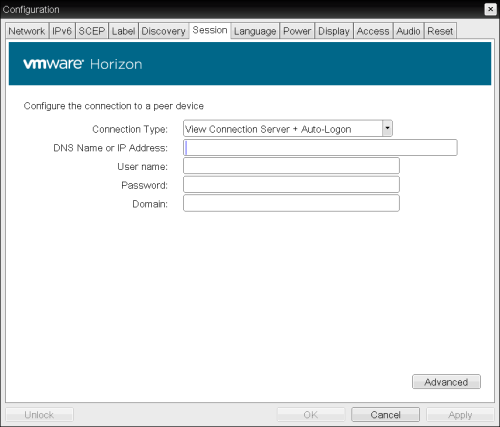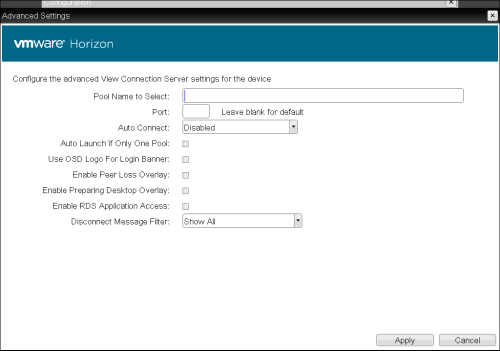
Select the View Connection Server + Auto-Logon session connection type from the Options > Configuration > Session page to configure a client to automatically enter a user's login details when a View Connection Server is used to connect to a VMware desktop.
Click the Advanced button to configure advanced settings for this option.
Important! Passwords are stored locally in retrievable form when zero clients are configured with this session connection type. For this reason, it should not be used in high security environments. Ensure that you take precautions to prevent theft of the zero client if you do use this session connection type.

OSD Session Connection Type – View Connection Server + Auto-Logon

Advanced Settings
OSD Session Page Parameters
| Parameter | Description |
|---|---|
|
DNS Name or IP Address |
Enter the View Connection Server's DNS name or IP address. For VMware Horizon DaaS, this is the DNS name or IP address of the VMware Horizon DaaS Desktop Portal. |
|
User name |
Enter the username for the client (maximum number of characters is 128). This username will be sent to the specified connection server. |
| Password |
Enter the password for the client (maximum number of characters is 128). This password will be sent to the specified connection server. |
| Domain |
Enter the domain for the client (maximum number of characters is 256). This domain will be sent to the specified connection server. |
|
Pool Name to Select |
Enter the pool name. When the list includes a pool with this name, the client will immediately start a session with that pool. Note: This field is case-insensitive. For Tera1 zero clients, this parameter is called Desktop Name to Select. |
|
Port |
By default, port 443 is used to communicate with the connection server. If your network is set up to use a non-standard port for secure connections, enter the port number. |
|
Auto Connect |
This field determines the client's auto connect behavior after startup:
Note: Devices running firmware 4.1.1 or lower do not support Retry On Error behavior and will always perform a single attempt to contact the connection server when this option is selected. Note: After enabling Auto Connect, the client must be power-cycled for the change to take effect. |
|
Auto Launch If Only One Pool |
When enabled, users are automatically connected to a provisioned desktop or application after user credentials are entered. Note: For Tera1 zero clients, this parameter is called Auto Launch If Only One Desktop. Note: This feature only applies to users who are entitled to a single desktop. It does not apply to users entitled to multiple virtual desktops. |
|
Use OSD Logo for Login Banner |
When enabled, the OSD logo banner appears at the top of login screens in place of the default banner. You can upload an OSD logo from the OSD Logo Upload page. |
| Enable Peer Loss Overlay |
When enabled, the “Network Connection Lost” overlay appears on the display(s) when a loss of network connectivity is detected. Normal hypervisor scheduling delays can falsely trigger this message. Note: This option is only available for a zero client. Desktop applications that require the peer loss notification should re-enable the feature through the OSD, AWI, or MC. |
|
Enable Preparing Desktop Overlay |
When enabled, the "Preparing Desktop" overlay appears on the display(s) when users log in. Note: This overlay provides assurance that login is proceeding if the desktop takes more than a few seconds to appear. |
|
When enabled and users connect to a VMware Horizon View Connection Server that offers applications, a list of available applications will be presented. Note: Applications open in full-screen mode, but can be re-sized once users are in session. |
|
|
Disconnect Message Filter |
This field lets you control what type of messages appear when a session is disconnected. There are three categories: Information: User- or administrator-initiated actions affecting the session:
Warning: System-initiated, but expected actions affecting the session:
Error: Unexpected system-initiated actions causing session to fail:
Note: For detailed information about the above session disconnect codes, please see KB 15134-872 in the Teradici Support Site. You can choose to display:
|